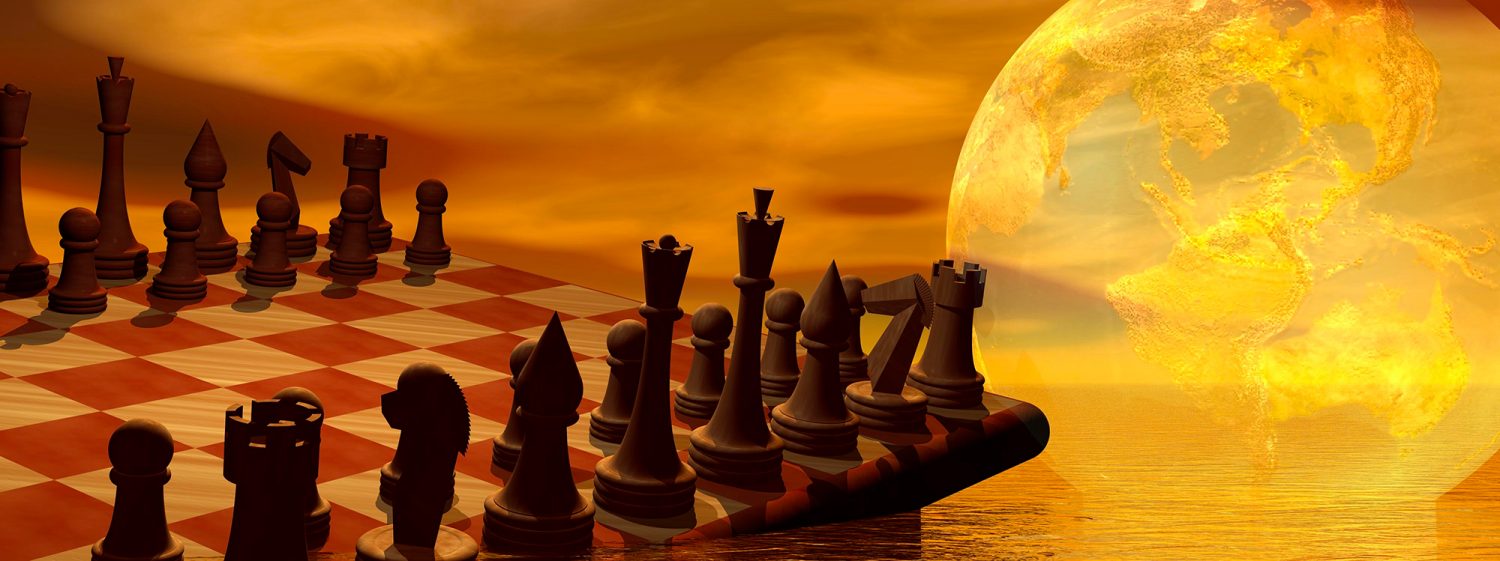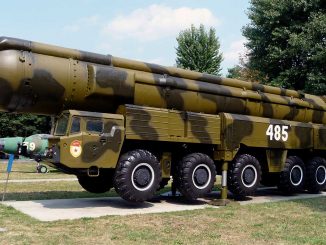Rear Admiral Mike Brookes, USN Commander, Office of Naval Intelligence, Delivers Remarks at Sea Air Space Conference — Washington D.C., April 5, 2023 — Source : US Navy —
My job as a commander of one of the eighteen Intelligence agencies is to highlight dangers facing our country. It’s my responsibility to look at geopolitical trends, global challenges, and military developments; specifically, those impacting the maritime domain–under the sea, on the sea, and over the sea.
Table of Contents
There’s plenty to worry about in the maritime environment. Just three weeks ago, two Russian SU-27 fighter jets made multiple runs dumping gas on a U.S. MQ-9 drone flying in international airspace in the Black Sea. Poor piloting from the Russians resulted in a collision with the MQ-9, which led to the MQ-9’s downing.
Illegal, Dangerous, Destabilizing Behaviors of China’s Frontline Forces
Russia is not alone in playing with fire in the international commons and risking serious escalation. Like its close friend, China seems to think it’s also okay to conduct high-risk activities with its frontline forces.
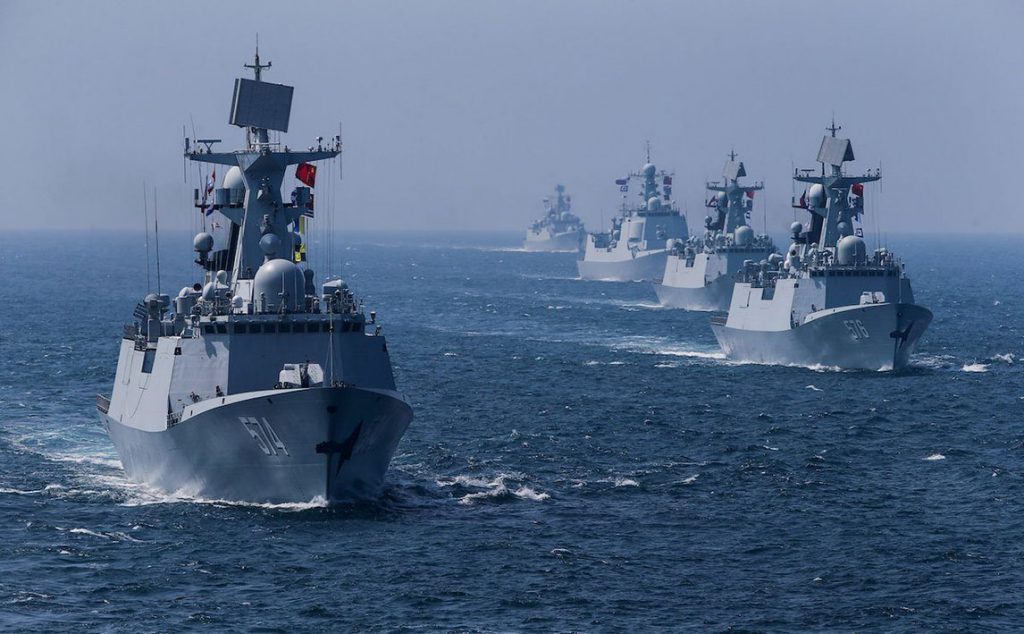
The Chinese have been periodically flying their fighters much closer to U.S. aircraft than ever before. For many years, the Chinese would react to U.S. operations in international airspace, but they would stand-off by a matter of miles on average. However, in the last few years, we’ve experienced over 100 fighter intercepts that have approached within 100 feet of U.S. and allied aircraft, sometimes within 10 to 20 feet of those aircraft. This means that if there’s one single twitch of the stick in the cockpit of those fighters, disaster is just a second away. This photo (referring to supporting graphics) shows how close a PRC J-11 fighter jet flew near the cockpit of a U.S. RC-135, one of our unarmed surveillance aircraft flying in international airspace.
These kinds of dangerous PRC behaviors are not just concentrated against the U.S., but are also directed at our allies. In May 2022, a Chinese J-16 fighter harassed an unarmed Australian P-8 patrol aircraft operating in international airspace in the eastern portion of the South China Sea, far away from China. While crossing in front, without warning the Chinese pilot dispensed clouds of chaff, the thin aluminum strips used to evade a radar-guided missile in combat. The chaff was ingested into the jet engines of the Australian aircraft, endangering the crew, which was lucky to bring back the jet safely.
In the East China Sea, Chinese fighters have also harried Canadian patrol aircraft engaged in patrols in international airspace designed to help enforce U.N. Security Council Resolution sanctions against North Korea. China signed on to those U.N. resolutions, yet still acts in risky, highly assertive ways that hazard air crews. These kinds of interactions are occurring all too frequently, though China will either deny they occur or blame others when they occur.
It’s not just close proximity operations that we worry about. China routinely engages in radio intimidation, giving repeated warnings to ships and aircraft operating in international spaces, threatening consequences. Threatening with language insinuating that China has unilateral control over what the rest of the world recognizes as international air and waterspace.
On the surface of the sea, Chinese Maritime Militia vessels, the China Coast Guard, and the PLA Navy operate in synchronicity to pressure foreign forces inside the so-called “nine-dashed line,” which is China’s massive, illegal, extraterritorial claim to most of the South China Sea. The Militia and Coast Guard have rammed foreign ships, water cannoned other vessels, interfered with legitimate resource exploration activities sponsored by other nations, driven off Southeast Asia nations’ fishermen in their own waters, and engaged in many other harassment tactics as they try to enforce their unlawful claims and cow other nations into giving China de facto control of whatever Beijing unilaterally claims in contravention of the U.N. Convention of the Law of the Sea (UNCLOS),
When it chooses, China also intentionally violates COLREGs and CUES, two agreements designed for safety at sea. COLREGs are International Regulations for Preventing Collisions at Sea, which were published by the International Maritime Organization in 1972. CUES stands for the Code for Unplanned Encounters at Sea, which has been in existence since 2014. China has signed both, but ignores them at unpredictable times. One example is a PLA LUYANG destroyer dangerously cutting across the bow of a US destroyer in 2018. Another Chinese tactic we’ve seen recently involves a PLA auxiliary putting themselves on a collision course with a foreign vessel, falsely signaling that they’ve lost control of steerage, and claiming “stand-on” rights to force the other ship to give way and change course. These behaviors reflect a brazen disregard for basic safety guidelines and show how flagrantly China flouts international strictures they promised to abide.
The Chinese also menace with military-grade lasers, like the recent case of a Coast Guard ship lasing a Philippine resupply ship making for one of the Philippine’s outposts in the South China Sea. True professionals, the Philippines have recognized the best way to deal with this is not by responding with guns or missiles. The know their best “weapon system” is a video camera to show the world what’s happening and expose China’s pattern of bullying and unsafe behavior. China also directed eye-damaging lasing against an Australian patrol aircraft monitoring a PLA Task Group operating just north of Australia, and in the past has used lasers against U.S. pilots landing in Djibouti.
There are other ways China systematically bends, breaks, or tries to skirt around international norms, conventions, and laws. For ten years, the Chinese have been covertly attempting to build up a number of cays in the Spratly Islands zone. We have seen them try to raise submerged or partly submerged sandbars and reefs to become above-water features by dumping loads of sandbags. Their auxiliaries have been offloading tractors to bulldoze sand around to further enlarge these features.
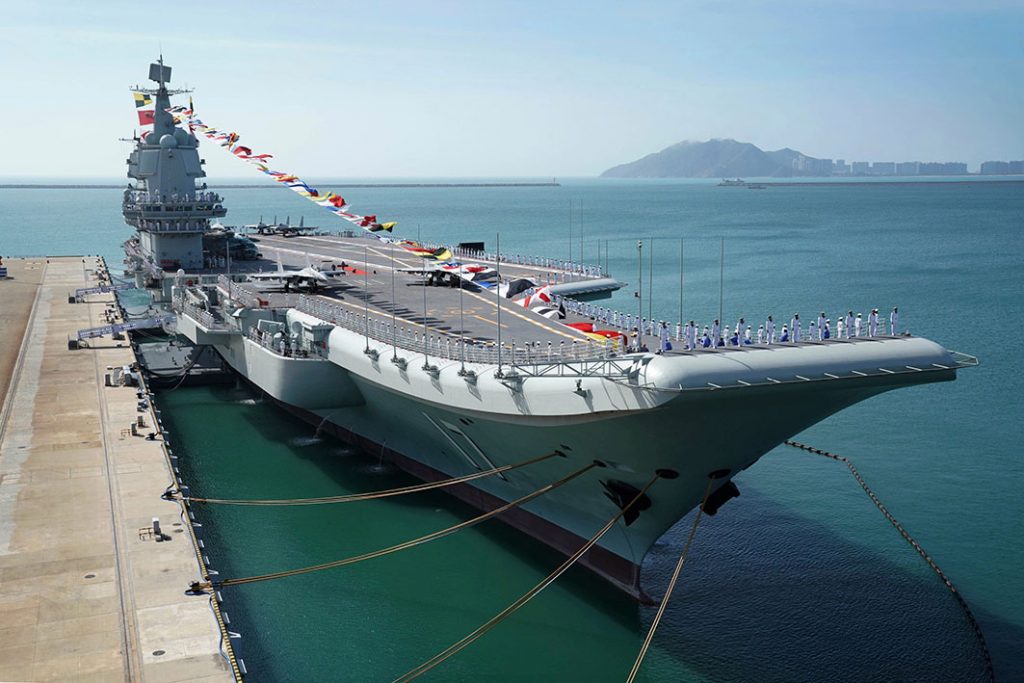
The Chinese lawfare gambit is to try to use these features as anchor points to claim exclusive economic zones and territorial water rights using a new rationale they concocted called “offshore archipelagos for continental states.” China knows manmade islets don’t qualify for any Exclusive Economic Zone (EEZ) claims, so they try to build them up secretly and pretend they naturally formed. At the same time, they are desperately trying to reshape the U.N. Convention on the Law of the Sea (UNCLOS), or at least alter the way its interpreted, which today clearly defines what is a continental state and what is an archipelagic state. China is definitively, based on many factors under UNCLOS, the former and not the latter. (Fiji, Philippines, Indonesia, however, are examples of nations that are officially able to claim archipelagic status.)
Just like their unlawful claim to own everything inside the “nine-dashed line,” most recently Beijing has illegally claimed jurisdiction over the Taiwan Strait, a highly-trafficked international waterway. More disturbingly, Beijing has started to slowly condition the region to the possibilities of “boarding and inspections” in these international spaces using its Maritime Safety Administration forces. China is likely going to slowly, patiently, lay the groundwork to justify future extraterritorial and extralegal actions in the Taiwan Strait, either directed at Taiwan or any other foreign forces it feels shouldn’t operate there—all of which constitutes a direct threat to a major international sea line of communication.
Not only does the region have to worry about what China’s frontline forces are doing beyond their legitimate borders as they try to control more areas in the First Island China, but many countries have been confronted with even more invasive operations. China’s auxiliaries often operate without permission in other nations’ EEZs doing military and resource surveys. Chinese distant water fishing fleets continue to illegally overexploit and deplete fishing stocks in other nations’ littorals. And Chinese surveillance balloons have recklessly and repeatedly flown through scores of nations’ sovereign airspaces in clear violation of international law.
Does Xi Jinping have Control Over His Frontline Forces?
All of these activities beg several questions. The first one we need to ask ourselves is whether or not Xi Jinping has lost control of his frontline forces. Are the frontline forces free to do what they like, or are these high-risk tactics deliberated on and approved on high by Xi Jinping?
Well, first, it’s clear that Xi Jinping wants to be in control of everything. In a remarkable bureaucratic feat of maneuvering, Xi has been able to throw out the collective leadership practices that marked the last 50 years of how China made decisions. He has concentrated more power than anyone since Mao. He has successfully placed himself in charge of all major “Leading Groups,” which coordinate everything from national security to domestic policy. Xi also eliminated the power of other networks and factions that had been serving as counterbalancing forces within the Chinese decision-making system. Recall the image of Hu Jintao, the former president, being physically lifted out of his seat, manhandled and escorted out of the last National Party Congress. That was Xi symbolically proclaiming there is no other power except his own in today’s China. So, Xi is clearly in charge, and he’s notoriously architected a chain of command so that all major decisions either flow up or down from him.
Let’s consider a second possibility: Has Xi Jinping unleashed forces that he can’t control? Has he given excess license to his subordinates to take actions at the tactical level, even if they carry potential strategic effects? Do commanders of frontline forces exercise too much freedom of action, because Xi is preoccupied or overburdened?
Indeed, it’s hard to believe that Xi can maintain enough span of control to allow him to have cognizance of everything that his forces are doing. Overconcentration of power at the top naturally creates gaps and seams in governance. It is very possible Xi has been surprised, pretended he wasn’t, and covered down with damage control measures while trying to sustain the image of infallibility of his rule.
A glimmer of insight into this dynamic takes us out to the far west of China, to the Line of Actual Control (LAC) with India, where an aggressive Western Military Region commander orchestrated patrols and set up encampments beyond China’s lines in the first of a series of major provocations, violating years of protocols that had kept peace on the LAC. The friction ultimately led to dozens of deaths and bloodletting in Galwan Valley in mid-2020, creating near-war conditions between two nuclear powers and quickly destroying years of hard-earned bilateral trust. In this case study, one has to conclude Xi Jinping is either geopolitically incompetent…or Xi was compelled to provide retrospective support, doubling down on the miscalculation of his generals. To some, it smells a lot like a military region commander became the tail that wagged the Beijing dog.
A third important question: Does Xi Jinping actively encourage assertive, even belligerent execution of his policies because he values loyalty to the China dream above everything else, literally at almost any cost? In the fever to realize China’s rise, is he willing to brook almost anything that his forces do so long as China ends up being advantaged, comes out on top, or looks strong? It’s reasonable to think that Xi may be either explicitly or implicitly sending the message down chain that it’s better to over-execute than to under-execute. It’s better to err on the side of aggressiveness. So Xi, in effect, may be consciously letting his wolf warriors and hawks loose on China’s neighbors and other nations.
Implications of Xi Jinping’s Choices
Let’s put this all back together. The truth about the motivations, behaviors, and controls over China’s frontline forces is likely found somewhere in the middle of all three of the central questions offered above.
Chairman Xi has certainly emerged as one of the most powerful leaders China has ever seen. He does act like an emperor eagerly building empire. He clearly whips up fervency for China’s rejuvenation. And he does support using almost any measure and method available to achieve his dream of supremacy, the sooner the better. With a remarkable degree of tone-deafness, Xi continues to demonstrate a willingness to sanction tactics and approaches long after they prove to be counterproductive to China’s reputation and long-term interests, even if they erode trust for China in the region, and even if they make everything the PRC do seem suspect.
We have strong indications that Xi Jinping is generally aware of most things his frontline forces are doing, but not everything they are doing, which is perhaps a function of the unwieldiness of China’s governance model. History warns us of the dangers of dictatorships, the distortions in totalitarian states, where the truth doesn’t always flow quickly to an all-powerful authoritarian. Bad news is adulterated on the way up to Big Brother. Half-truths, falsities, incomplete data, and rosier-than-right reports thrive in bureaucratically threatening systems, because civil servants and generals are perpetually scared. They quite naturally protect themselves because there are few safeguards or protections for individuals. And history tells us that in tyrannical societies of this nature, this phenomenon is only going to get worse with time as information is increasingly modified to provide news the autocrat wants to hear.
What this means, overall, is that we’re living in more unpredictable and dangerous times, when anything can happen. Going forward, the Indo-Pacific region and the world must not just contend with the dread of a hulking, temperamental China, but also its ever-growing war machine, which is a destabilizing force unto itself. We must not just grapple with the idea that China is becoming increasingly comfortable with using raw, naked power to advance its interests in almost every sector. Now we also need to worry about Chinese minions of all stripes that are eager to please, feel like they have a license to over-execute, and in their zealotry may end up committing a number of tactical mistakes or mishaps that could result in ruinous strategic outcomes. Recall the 2001 disaster, when an over-exuberant and under-skilled Chinese pilot hit a U.S. EP-3 operating on a routine patrol in international airspace.

The U.S. recognizes all these dangers, of course, and is responsibly trying to make sure we have reliable lines of communication with the Chinese, including “hot lines.” While we have multiple physical means of communicating with the PLA, the CCP generally continues to view communications as a lever to reward or punish not just the U.S., but nearly all foreign interlocutors. Simply stated, the PLA will talk only when they perceive such communication as an advantage—not, unfortunately, during an unfolding crisis, not following an incident, and to not to discuss strategic frictions. It would be in their best interest to do so, of course, especially since senior Chinese leaders may get a better set of facts (and sooner) from the American side than their own.
Rear Admiral Mike Brookes, USN Commander, Office of Naval Intelligence — US Navy Photo
Meanwhile we can expect China to continue executing its grand strategy, which involves applying significant energy to advance its creeping expansionistic agenda. They’ll move forward using enticements, like dangling Belt and Road Initiative capital, and they’ll move forward using “gray zone” coercion, because they think these carrots and sticks work. But, unfortunately, we may not be able to trust that Xi is going to be sufficiently in control of his frontline forces.
This problem will likely get worse as China fields more unmanned systems. China is already deploying thousands of unmanned systems and the prospects that China will employ them for additional surveillance, harassment, exploitation, interference, and intimidation is high. We’ve already seen China deploy an incredible number of buoys–floating and anchored, unmanned surface vehicles, and unmanned underwater vehicles in the First Island Chain, around Taiwan, West Philippine Sea, Bering Sea, Central Pacific, near Australia, Indian Ocean, polar regions, and even around Africa. What are they doing with all these systems, the world should wonder?
In the end, if you exercise ultimate power, then you also own ultimate responsibility for what your forces do. Xi is the authoritarian atop an absolutist state, and he has the power to alter what his forces do or don’t do. Xi remains the accountable entity for all actions of his frontline forces.
China’s Rationale for Aggressive Frontline Force Behaviors
If a Chinese official was here, he would reject all the above and claim China is the real victim in all this. He would say the U.S. remains locked into a “Cold War mindset” using outdated alliance systems, or blocs, that threaten China. He would declare that U.S. operations in the Indo-Pacific generate friction among nations and profess that our presence is fundamentally destabilizing. He would say America shouldn’t be in the Western Pacific in the first place. He might mention what a Chinese Defense Minister said years ago, that “Asia is for Asians,” a term coined by Imperial Japan in WWII—the same regime that touted the “East Asian Co-Prosperity Sphere” (which, by the way, has striking parallels to China’s Belt and Road Initiative language).
The PRC official would say America and its allies constantly operate in China’s waters, in China’s airspace, or on China’s periphery. He would never admit that U.S. forces are actually operating lawfully in the international commons. He would proclaim that foreign air and maritime operations anywhere inside the first and second island chains are designed to keep China down, stop its rise, contain, encircle, and threaten China’s “core sovereignty” interests.
Truth told, this perspective makes a whole lot of sense if you’re stuck in a paranoiac Marxist-Leninist-style government that has a fundamental need of an archenemy—a longstanding opponent that China can blame for whatever ills affect the country, whatever sacrifices the country must make, or whatever actions they feel they must take externally in the name of “defense” for their country against a supposed implacable hegemon. This fear mongering is never going to go away on the Chinese side.
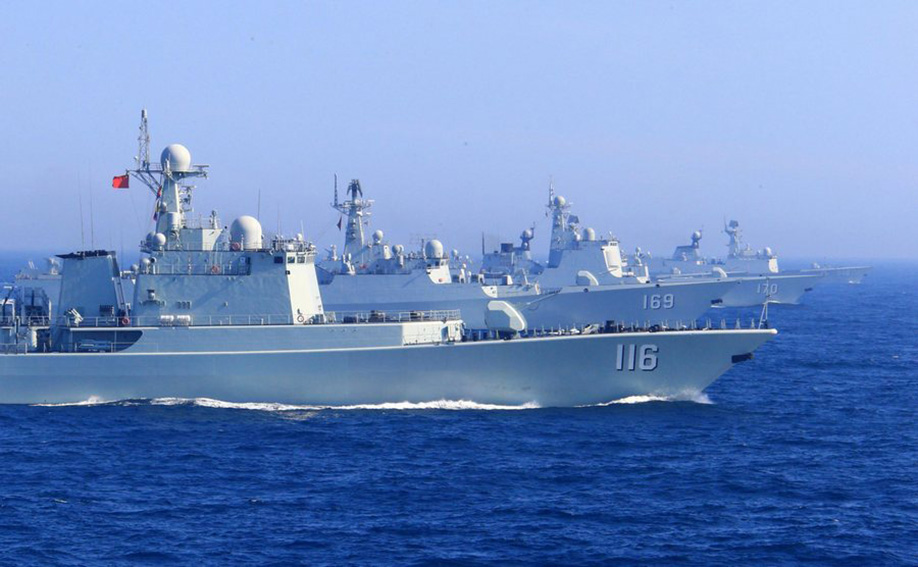
For all these reasons, China thinks America and its allies need to be pushed back and out. And they constantly experiment with novel ways to do that. Chinese academies, think tanks, and the PLA work round the clock to develop new tactics and techniques for their frontline forces, and they keep using whatever measures they can get away with—no matter how risky–if they think it helps achieve China’s goals.
On 60 minutes, Admiral Paparo, the Pacific Fleet commander, recently asked an important question. When China talks about America containing them, he asks, “China, are you doing anything that should be contained?” An analogy applies here. It’s like your neighbor not just claiming their own house and yard, but the public street in front of their house, the sidewalks, and then your own front lawn. And when you go out to deal with the attack dogs the neighbor left on your own front lawn, the offending neighbor himself feigns offense and cries, “you’re containing me!” Perhaps the neighbor should stick to his own legal property and simply follow public ordinances instead.
Why America Operates Forward in the Indo-Pacific
So let’s conclude this examination of China’s frontline force challenges with the real reasons why America is operating its forces in the Indo-Pacific:
First, the Indo-Pacific is central to the global economy and will increasingly be so. The manufacturing and production centers in this part of the world are indispensable engines of global economic growth. Likewise, the safe, free flow of commerce in this region serve as life-giving arteries for the international trading system.
Second, America has long been a Pacific power, and always will be.
Third, the U.S. and the vast majority of nations have a long-standing interest in the international order and the rules that have guided it well for so many decades. The international order created after WWII has helped lift more people out of poverty (60% of the planet, by some estimates) than any one thing.
Fourth, America has many alliances, but five of our seven are in the Indo-Pacific. In this era, these alliances have never been more important as we deal with revisionist powers trying to play by their own rules. These alliances are only becoming stronger as dangers manifest from North Korea, Russia, and China.
Fifth, Xi continues to rapidly modernize his military and funnels massive resources into every warfare area, in every domain, investing well beyond what China needs for its own legitimate defense.
Sixth, China is using its outsized military and security forces to project power and threaten its neighbors, placing more forces, more forward, more often. Xi appears to remain committed to using hard power to coerce, intimidate, and harass other nations in service of extraterritorial ambitions in areas unlawfully claimed by Beijing. China continues to insist on its right to enforce its domestic laws in international spaces, creating a highly disruptive dynamic that is generating regional fear and increasingly undermining stability in the Indo-Pacific.
And seventh, Beijing has sharply intensified threats toward Taiwan, a democratic, status quo partner of the United States that has expressed no intent to declare independence.
So, the U.S., as a force for peace, stability and security in the region, maintains tabs on these dangers. We are forward deployed monitoring potential flashpoint areas, providing warning to friends, and standing ready to respond to aggression if necessary.
We conduct operations to uphold the international system and protect vital waterways and airways with supreme professionalism (and a great deal of patience, I might add) to ensure a free and open Indo-Pacific for all. American forces continue to operate responsibly when and where needed to suitably protect the international commons from any infringements, and to avoid conceding–by either inattention or inaction–to dangerous precedent-setting behaviors. Behaviors that, if left to flourish in shadowy “gray zones,” will slowly chip away at the pillars of the existing international order, a rules-based system that has served all nations fairly and better than any previous global order in world history.
It’s worth reminding, as I conclude, that might does not equal right in the 21st century.
And one country’s dream should not be misappropriated at the expense of other nations’ rights and interests.
Thank you.
